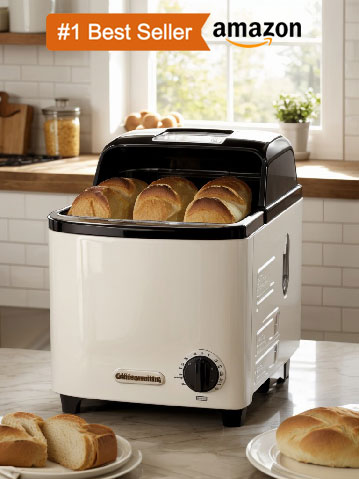Substituting Whole Wheat Flour For Bread Flour In Bread Machine
Baking with whole wheat flour can be a great way to add more nutrition to your home-baked goods. In particular, baking with whole wheat flour in a bread machine can be a relatively simple way to produce a delicious, healthy product. This guide will provide advice on how to successfully substitute whole wheat flour for bread flour when baking with a bread machine.

Whole wheat flour is denser than bread flour, so you may need to reduce the amount of flour used when substituting.
Whole wheat flour is a great choice for baking when you want a more wholesome, nutritious product. It is made from the entire wheat kernel, including the bran and germ, which adds a higher fiber content than traditional all-purpose or bread flour. Compared to other flours, whole wheat flour is denser and has a higher protein content.
When substituting it for other flours, it is important to note that you may need to reduce the amount of flour used as it is heavier than many others. Additionally, you may need to adjust the amount of liquid used as whole wheat flour absorbs more liquid than other varieties. When using it in recipes, take your time to incorporate it properly and mix until the dough is smooth and pliable. If you find that the dough is too stiff, add a bit more liquid. Ultimately, whole wheat flour is a great choice when you want to add a nutritious boost to your baking.
Whole wheat flour contains more fiber and protein than bread flour, which can lead to a heavier texture.
Whole wheat flour is a great choice for baking because it contains more fiber and protein than bread flour, making it an excellent source of nutrition. The higher fiber and protein content of whole wheat flour gives baked goods a heavier texture. This is due to the increased amount of gluten formed when mixed with water, which makes the dough more resilient and less likely to flatten out during baking.
This makes whole wheat flour an ideal choice for baking breads, muffins, and other hearty baked goods that require a dense crumb structure. The extra fiber and protein also make whole wheat flour a good choice for those looking to increase their intake of these important nutrients. Additionally, the unique flavor of whole wheat flour adds a pleasant nuttiness to baked goods, making them stand out from those made with all-purpose flour. Overall, whole wheat flour is an excellent ingredient for creating nutritious and delicious baked goods.
See also: How To Use Active Yeast In Bread Machine
Whole wheat flour absorbs more liquid than bread flour, so you may need to increase the amount of liquid in the recipe.
Whole wheat flour absorbs more liquid than bread flour due to its higher protein and fiber content. This means that when baking with whole wheat flour, you may need to adjust the recipe by adding extra liquid. If a recipe calls for one cup of bread flour, you may need to use 1 1/4 cups of whole wheat flour to achieve the same results.
Additionally, you may need to increase the amount of liquid in the recipe. This could be done by increasing the amount of water, milk, or other liquid called for in the recipe. It is important to take into account the other ingredients used in the recipe as well, such as butter, eggs, and sugar, as these can also affect the amount of liquid needed. It is also important to note that using whole wheat flour will give a denser texture to the final product, so you may need to adjust baking time accordingly.
See also: Making Jam In A Panasonic Bread Machine
If the recipe requires a dough hook, whole wheat flour can be more difficult to work with than bread flour.
Using whole wheat flour when a recipe calls for a dough hook can be tricky. Whole wheat flour is denser than bread flour and contains more gluten, making it harder to knead. This can make it difficult to keep the dough from becoming too sticky and difficult to work with.
The dough also tends to form more air pockets, which can make it difficult to get a uniform texture. Additionally, the added gluten in whole wheat flour can cause the dough to become overworked more easily, resulting in a less elastic and tougher texture. To ensure success when working with whole wheat flour in a recipe that requires a dough hook, it's important to knead the dough for a shorter amount of time and to use a slightly lower speed setting on the mixer. It may also be helpful to add a bit more liquid to the dough recipe to help keep it from becoming too dry or stiff. With these tips in mind, you should be able to achieve a delicious and light finished product.
See also: Gluten Free Corn Bread In Bread Machine
Whole wheat flour has a shorter shelf life than bread flour and can become rancid faster.
Whole wheat flour has a shorter shelf life than bread flour since it contains more natural oils from the bran and germ. These oils can go rancid faster, especially in warm, humid environments. To prevent this from happening, whole wheat flour should be stored in a cool, dry place and used within a few months of purchasing.
If you don't think you'll use it up that quickly, you can store it in the refrigerator or freezer to extend its shelf life. If your whole wheat flour has been stored improperly or for too long, it can start to smell unpleasant or have an off taste. In this case, it's best to discard it and purchase a new bag.
See also: Youtube How To Override Pre-Programmmed Settings On Bread Machine
Whole wheat flour can darken the bread and give it a stronger flavor.
Whole wheat flour is a great choice for bread making because it adds a unique flavor and a darker color to the finished product. Whole wheat flour is milled from whole wheat kernels, which contain all of the original nutrients and fiber of the grain. This creates a nuttier flavor than white flour and adds a healthy boost to the bread.
Whole wheat flour also absorbs more liquid than white flour, so it's important to adjust the liquid in the recipe to ensure the dough isn't too wet. Additionally, whole wheat flour contains more gluten, so kneading the dough for a longer period of time will help to develop a strong gluten structure for a better rise. Using whole wheat flour in bread baking can be a great way to add more nutrition and flavor to your favorite recipes.
See also: Why Is My Bread Machine Bread So Heavy
Whole wheat flour will not rise as high as bread flour, so you may need to adjust the baking time and temperature accordingly.
Whole wheat flour is a nutritious and delicious alternative to white bread flour, but it does have some important differences that should be taken into account when baking. Whole wheat flour contains more fiber and other nutrients than white bread flour, but it has a lower gluten content, which means that it won't rise as high or form the same stretchy texture. When baking with whole wheat flour, you may need to adjust the baking time and temperature to accommodate its lower rising power.
Additionally, adding a teaspoon of baking powder or baking soda per cup of whole wheat flour can help to give the dough more lift. To keep the finished product from becoming overly dense, be sure to knead the dough for longer than you would with white bread flour. With a few adjustments, you can still enjoy delicious and nutritious home-baked breads, even when using whole wheat flour.
Whole wheat flour requires more yeast than bread flour, so you may need to increase the amount of yeast used in the recipe.
Whole wheat flour is a heartier and denser type of flour compared to bread flour, so it requires more yeast in order to rise properly. When baking with whole wheat flour, the amount of yeast used should be increased by at least 25%. This additional yeast helps to activate the gluten in the flour, resulting in a lighter, airy texture.
If you're using a recipe that calls for bread flour, but you want to use whole wheat flour instead, be sure to increase the amount of yeast used. It's also important to let the dough rise for a longer period of time than usual, as whole wheat flour takes longer to rise than bread flour. With the right amount of yeast and extended rising time, you can create delicious whole wheat breads that are light and fluffy.
If the bread machine has a whole wheat setting, it is best to use that setting when using whole wheat flour.
Using the whole wheat setting on a bread machine is the best way to ensure that whole wheat flour is used to its fullest potential. This setting is designed to maximize the unique characteristics of whole wheat flour, such as its nutty flavor, texture, and nutritional profile. It ensures that the gluten structure is properly developed, allowing the dough to properly rise and create a desired texture.
Whole wheat flour is denser than other types of flour, so the additional kneading and rising times of the whole wheat setting help to break down the bran and germ and make sure that all of the ingredients are properly mixed. The whole wheat setting is a great option for those looking to make healthy and delicious whole wheat breads.
Whole wheat flour can make the bread more dense and can lead to a shorter shelf life, so it is best to consume it soon after baking for the best results.
Whole wheat flour is a healthier alternative to regular white flour and can add a lot of flavor and texture to your baked goods. It is made from grinding the entire grain of wheat, including the bran and germ, which provides a higher fiber content than white flour. When using whole wheat flour in baking, it is important to note that the resulting product will be more dense than when using white flour and may have a shorter shelf life.
For this reason, it is best to consume the baked goods soon after baking to get the best quality and flavor. Whole wheat flour can also absorb more liquids than white flour, so it is important to adjust the recipe accordingly. Additionally, whole wheat flour should be stored in an airtight container in a cool, dry place for up to six months. With the right adjustments and storage, whole wheat flour can be a great addition to any baking recipe.





